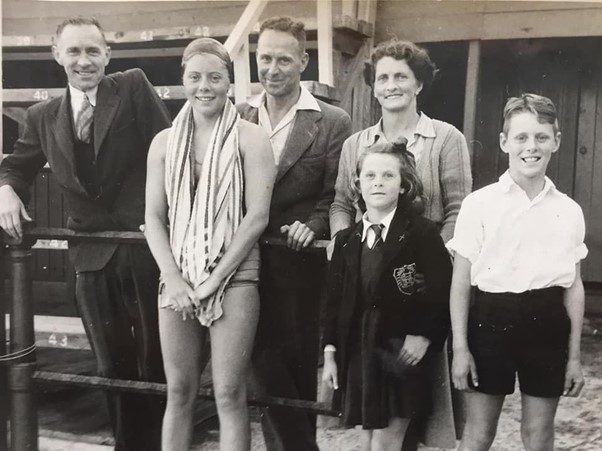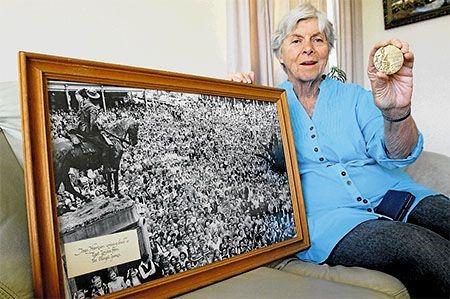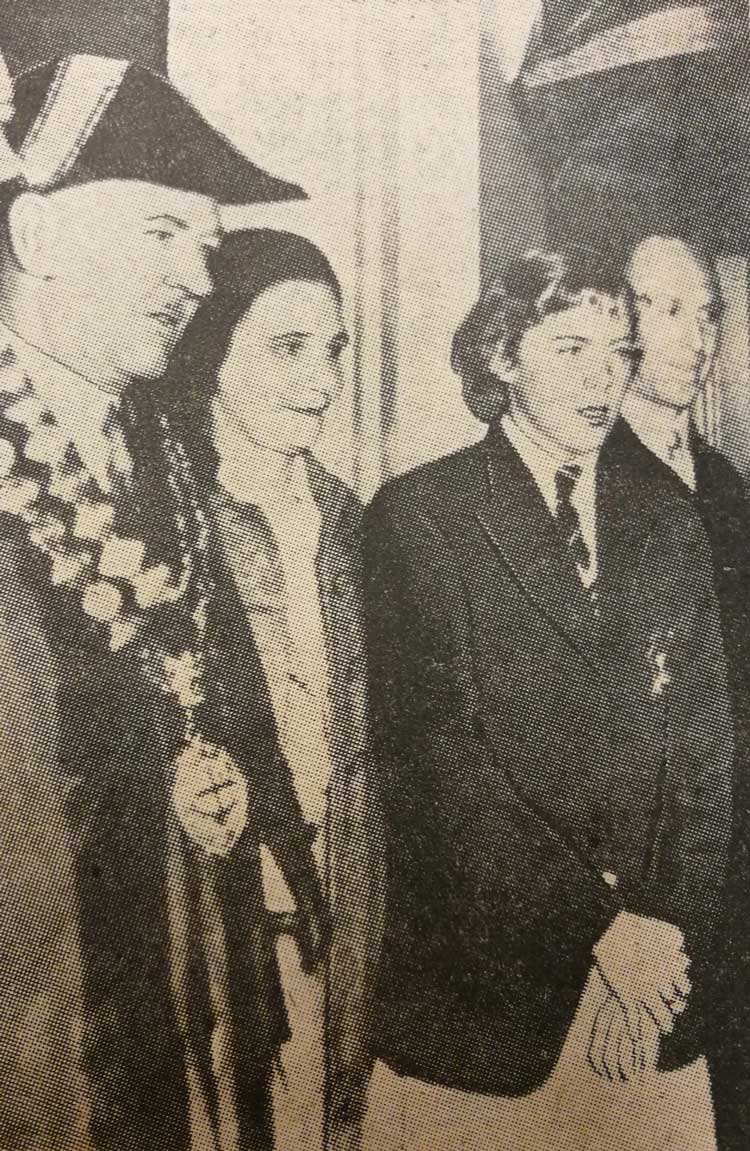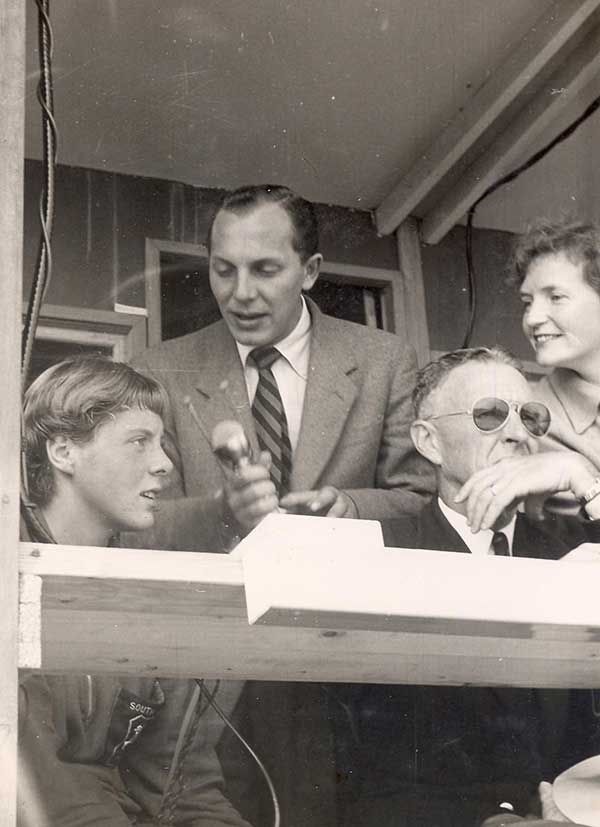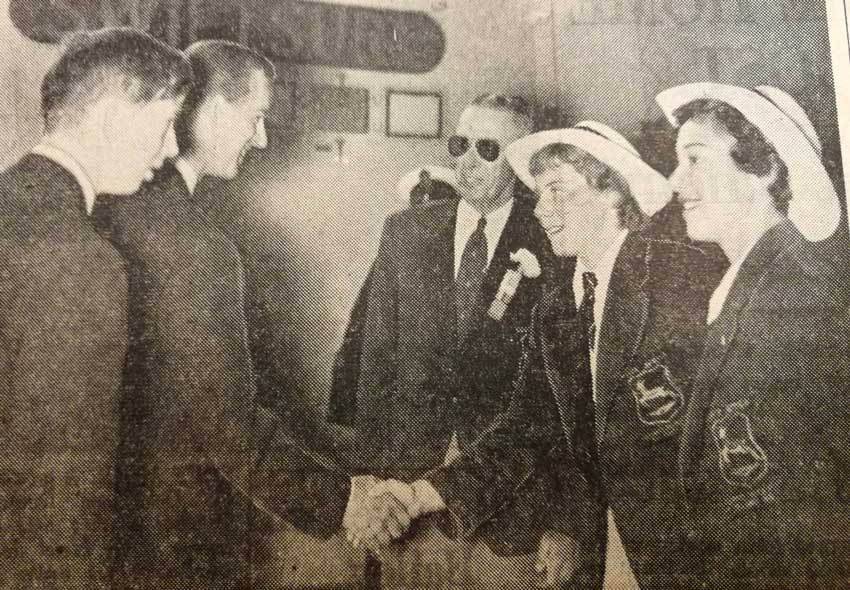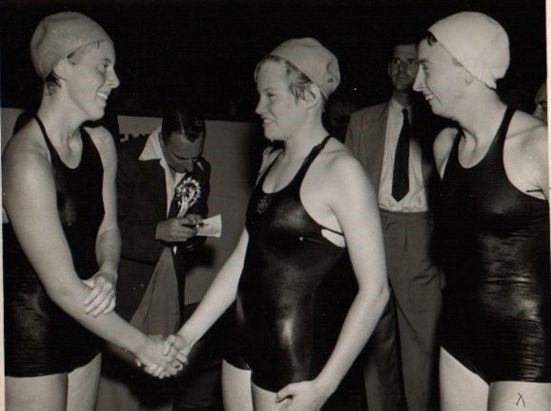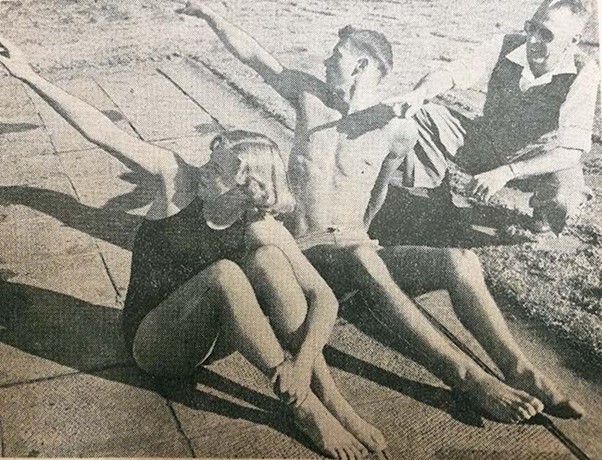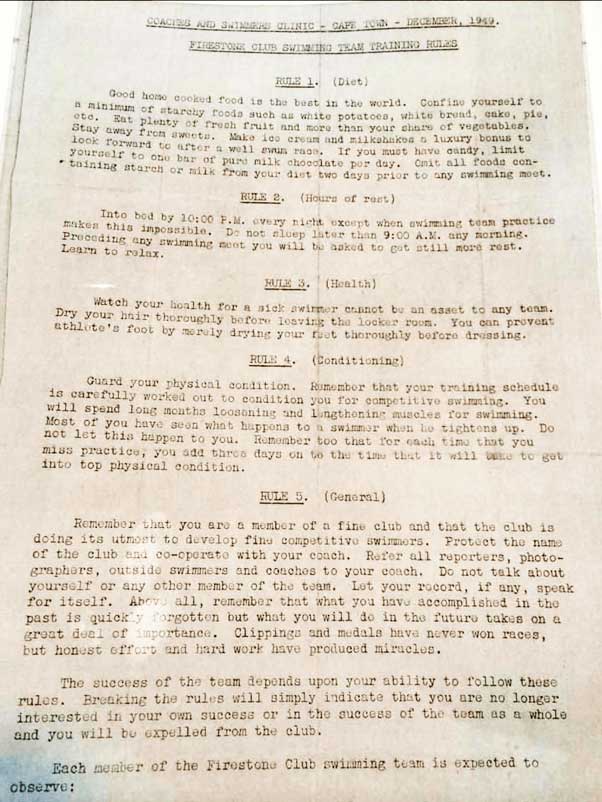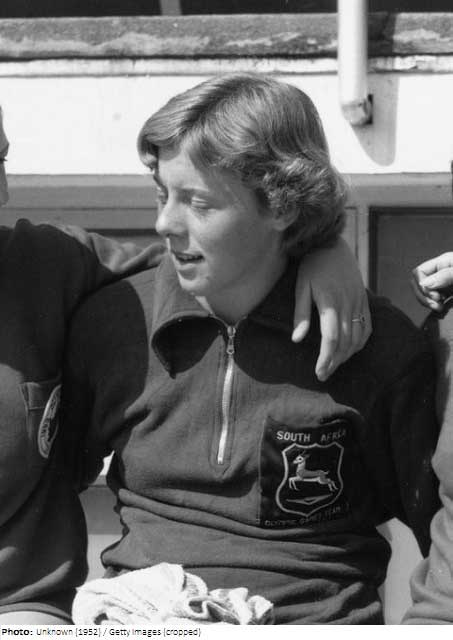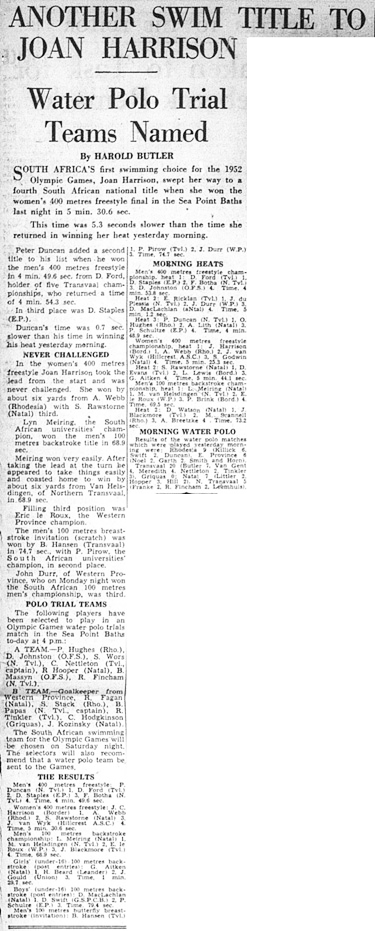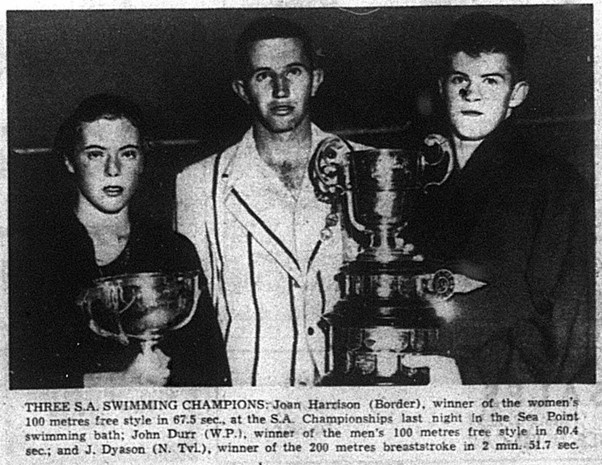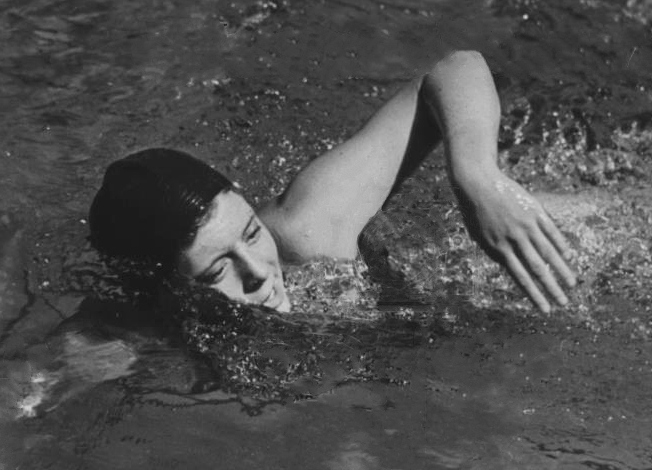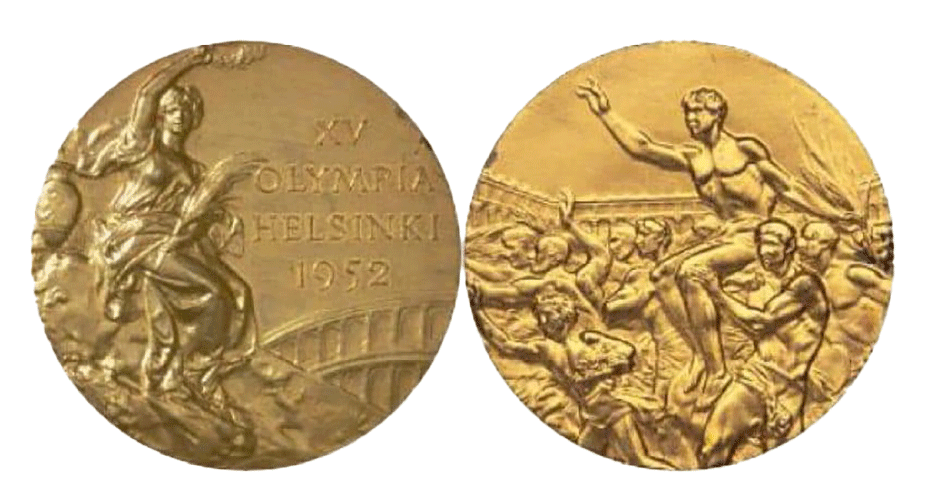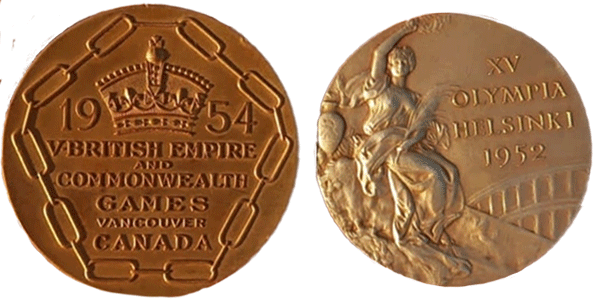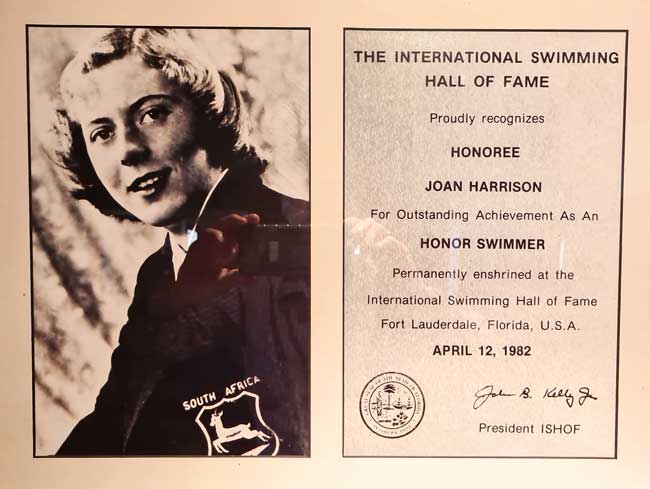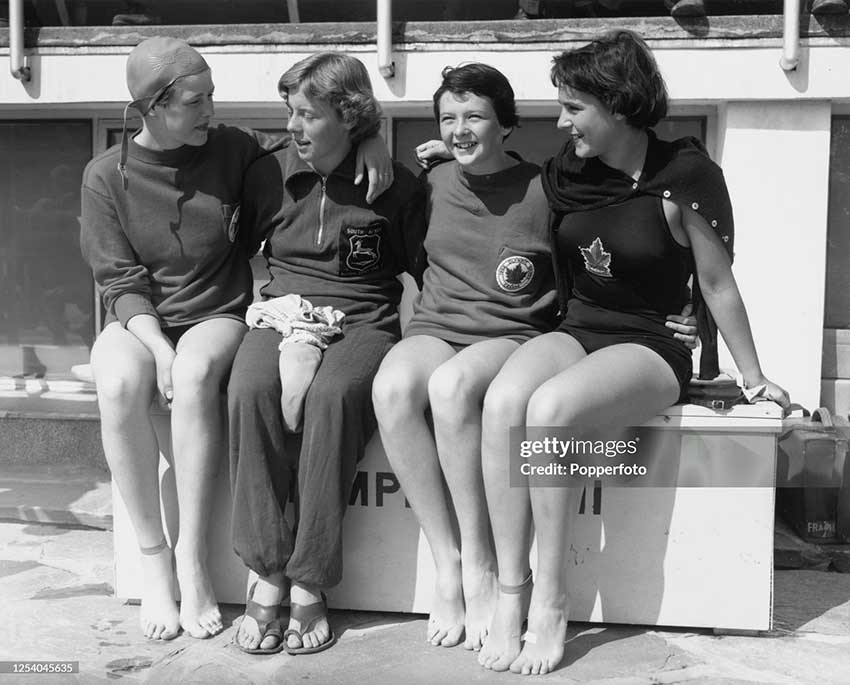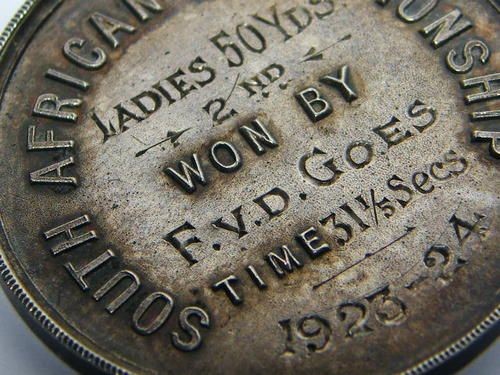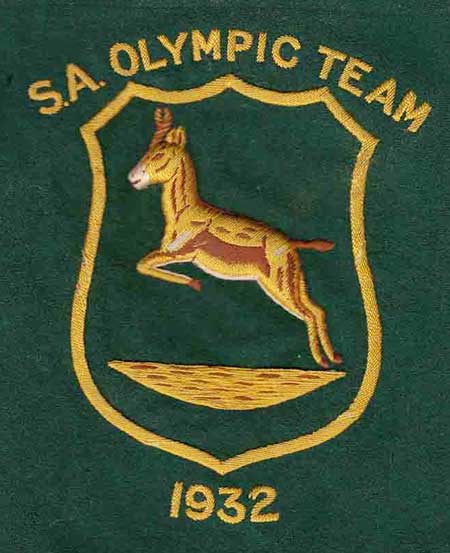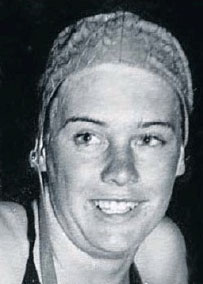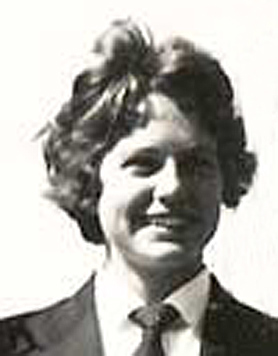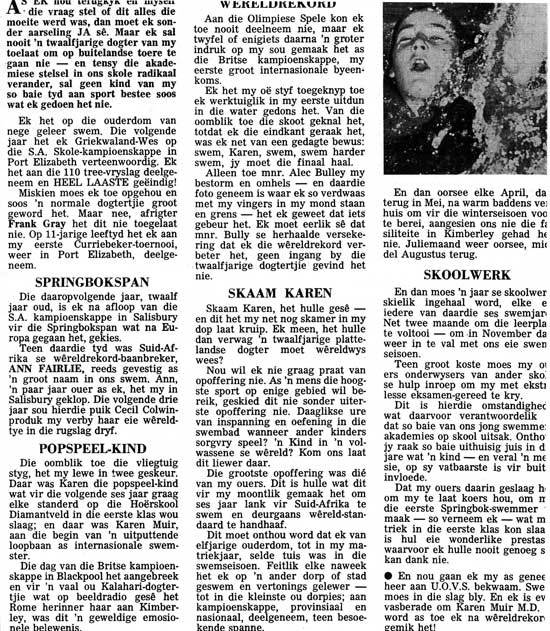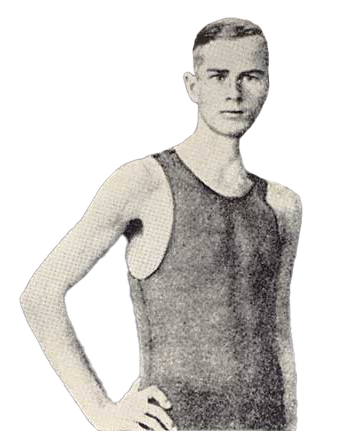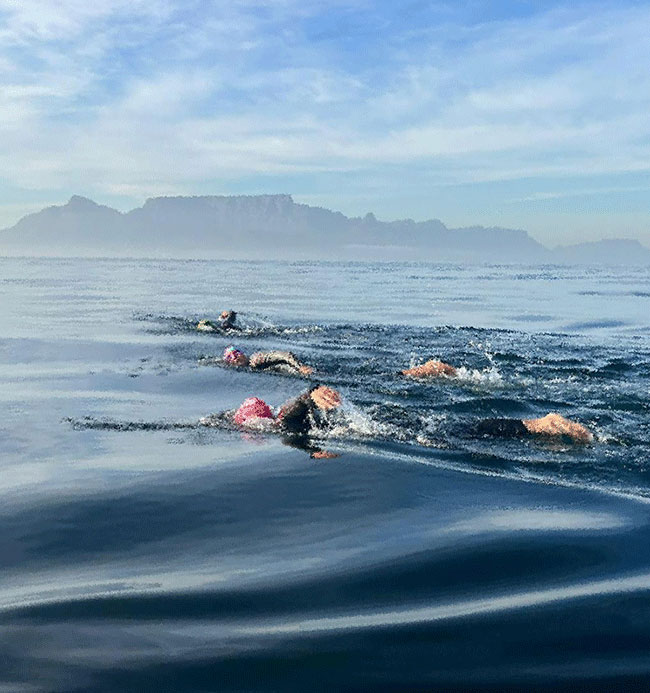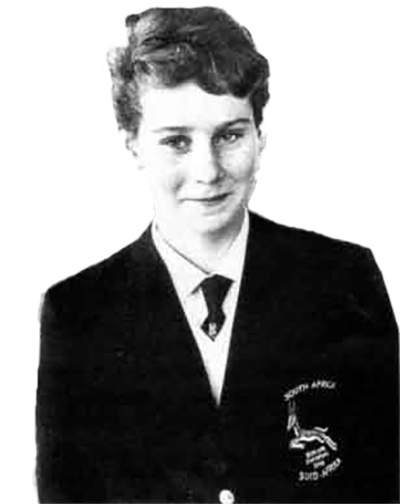Posted in Champions.
18 world records
Karen Muir dominated international women's backstroke events from 1965 - 1969
Despite the international boycott of South African athletes, Karen Muir set 18 world records between 1965 and 1969 and various events and distances. Note that during that period the swimming world was moving from 55-yard to 50-meter pools. Because a 110-yard swim was further than 100 meters, one swim could result in two records.
Taking time from school, she travelled overseas every year to swim against the world's best, usually beating all comers. Olympic champions and medallists like Kathy Ferguson, Elain Tanner and Kiki Caron came to her home town Kimberley, because she held the world records.
The beginning
Born on 16th September 1952, and raised in Kimberley, her mother put her and her younger sister Liana into swimming at the local municipal pool. Her coaches included former swimmer Fiks Nel, and the pool superintendent Frank Gray, who had been recruited by the South African Amateur Swimming Union (SAASU) from Watford, England, to coach and develop swimming in the country. Gray was to play a major role in Karen's swimming career.
The following year, in March 1963 Karen was included in the Griqualand West Provincial Schools team to the national inter-schools championships in Port Elizabeth and an inter-club event at Zoo Lake in Johannesburg. Her life as a travelling swimmer had begun.
At the end of January 1964, the Griqualand West senior provincial team had to compete in the annual triangular gala against Border and the Orange Free State in East London, without their new star youngster Karen Muir. Frank Gray had persuaded the local officials to leave her behind, to focus on the local Griqualand West provincial championships, held the following week. She set four new provincial records and was selected to represent Griquas at the annual national championships, held in Port Elizabeth, at the end of February. In late February Karen swam in the local inter-high school championships - despite only being in standard 4 (one can imagine coach Frank Gray's influence here - getting his young swimmer some competitive swims before nationals).
1st Nationals - 1964 Port Elizabeth
When the Griqualand West swimmers travelled to the 1964 South African National Championships in Port Elizabeth, 11-year-old Karen was already a force in Griqua swimming. Swimmers were selected to compete at nationals only if they achieved national qualifying times set by SAASU. Most South African swimmers never achieve these qualifying times, and just making it to nationals was considered an achievement.
Long trips away on swimming tours were exciting. At the tender age of 11, she was the team's youngest member - and the only Afrikaner - travelling with the senior team members, officials, and the Rhodesian team, which had taken a break from their three-day journey in Kimberley. The annual tours to nationals were a feature of the South African swimming scene in those days. The South African swimming championships were held in locations from Cape Town to Salisbury, and the trips often lasted up to two weeks for some teams, travelling by train, and even by ship, in the early days.
Teams of youngsters, accompanied by managers and chaperones, stayed in hotels or lodging with local families, where they participated in 'initiation' ceremonies, and generally had a good time. No doubt Karen's parents experienced some moments of anxiety about their daughter's safety and well-being!
At her first nationals, Karen made the finals of both backstroke events - which was a notable achievement for a youngster - although she finished 6th (last) in each, with the 15-year-old Transvaal swimmer Ann Fairlie winning both titles.
Fairlie had set new South African records for both distances in 1963 - when she was 13, and was the youngest swimmer ever to have been awarded Springbok colours for swimming. Ann Fairlie, who was also to set backstroke world records - would have made quite an impression on young Karen Muir.
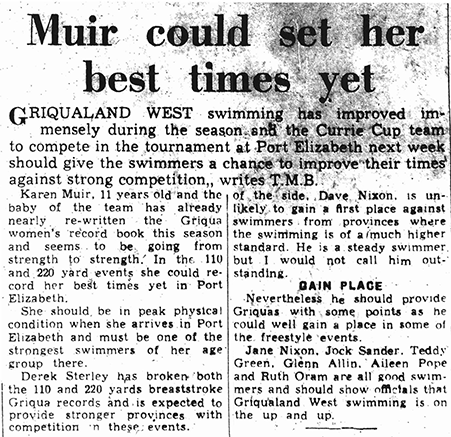
Elsewhere - on 18th August 1964 the International Olympic Committee voted to exclude South African athletes from the Olympic Games. This ban did not include officials, as SAASU President Harry Getz, an attorney from Cape Town, was named Chief Judge of the swimming events, at the 1964 Tokyo and 1968 Mexico Olympic Games. The ban officially ended any chance of Karen's future participation in the Olympic Games.
In October 1964 the South African Swimming Union entered a men's team to compete in the British ASA Championships, where they won 9 of the available 11 titles.
In 1965 SAASU again sent a team to the British nationals - this time they took the girls also, including 12-year-old Karen Muir. With Ann Fairlie already in the team, she was taken along as an 'additional' swimmer.

2nd Nationals - 1965 Salisbury, Rhodesia
In 1965 the South African nationals were held inland, at the Les Browne Pool in Salisbury, Rhodesia, at 5000 ft above sea level. Karen was by then a seasoned provincial swimmer, ready to make her mark on the national swimming scene. Fairlie had swum a 1:10,6 for the 110-yard backstroke earlier in the season, which was only 0,8 seconds outside the world record of 1:09.8, set by Britain's Jill Norfolk in the fast saltwater pool in Blackpool in April 1964. The Rhodesian press was touting Fairlie to break Norfolk's record 'at any time', but they were already beginning to take notice of young Karen.
Ann Fairlie won both backstroke events, but Karen was close behind her, in second place. In the 110-yard backstroke final Fairlie finished first in 1:11, 4 with Karen second in 1:13,7. The 220-yard backstroke was a repeat of the 100, as Fairlie won again, in a new South African record of 2:37,1 with Karen's time of 2:41,2.
Despite Ann Fairlie being the star of that year's nationals, for her achievements, Karen was awarded her Springbok colours - the pinnacle of achievement for any South African sportsman at the time, and she was still in primary school. As sometimes happened with precociously talented youngsters, Karen was to receive her high school colours for swimming long after winning a Springbok blazer!

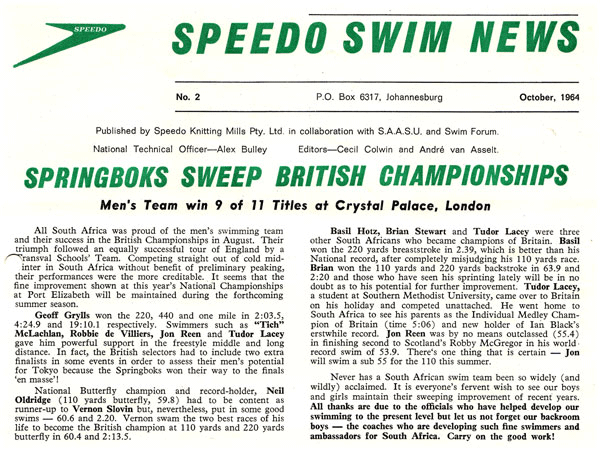
In the previous year - August 1964 - the South African swimming union had sent a Springbok men's team to compete in the British nationals, where they won 9 of 11 titles. In 1965 SAASU again sent a team to England - this time they took the girls also, including young Karen. With Ann Fairlie already in the team, she was taken along as an 'additional' swimmer.
The Springboks arrived with a reputation of dominance from the previous year - but the final result in 1965 would be unexpectedly spectacular.
World record number 1 - Blackpool, England, 10th August 1965
At the ASA Championships in Blackpool, Karen Muir swam in the heats of the Junior Girls 110 110-yard backstroke. The saltwater may have been a novelty to her, while the noise of a large and crowded Derby Bath indoor pool would also have been a new experience. From the start of the race, when she fell into the water, she just focused on swimming as fast as she could - to make the final.
To the amazement of the crowd and her surprise, Karen set a new world record of 1:08,7! The previous record of 1:09,5 was held by England's Linda Ludgrove - who was to compete against Ann Fairlie in the Women's event. The next day she swam a 1:08,9 in the final - once again under the old world mark of 1:09,5.
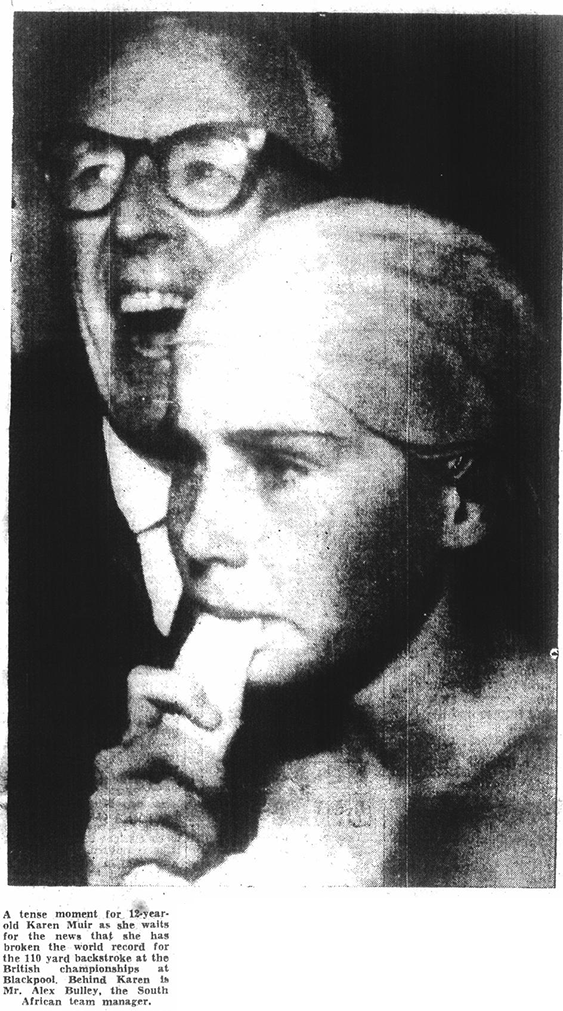

Quoted from Chris Steyl - Timid Torpedo - The legend that was Karen Muir:
Tuesday, 10 August 1965. In British terms, it's a lovely, hot summer day. The spectators at the Blackpool swimming complex are noticeably excited. This is the second day of the annual week-long ASA (Amateur Swimming Association) championships. They have all come to see their world champion, Linda Ludgrove, perform in the heats of the 220-yard backstroke event. And also to see her restore the good order again. The order in which Britain wields the sceptre over its colonies, and especially over South Africa. The previous day South Africa won the second cricket test against England at Trentbridge by 94 runs. And at this very ASA competition last year the South African men's swimming team won nine of the eleven titles. So all eyes will be on Linda Ludgrove tonight, making her mark for Britain in the ladies backstroke event. After all, Linda, the hairdresser from London, had set a new world record in the 110-yard backstroke two weeks ago. Tonight will also be an opportunity to see the new swimming sensation from South Africa, Ann Fairlie, in one of the other backstroke heats. These two swimmers are sure contenders for the 220-yard backstroke final scheduled for Wednesday. There is a buzz among the crowd and the sound reverberates under the closed roof of the Blackpool complex.
Doods, the girls' chaperone during the tour, immediately arranges for Karen to return to the hotel to recover before the 220-yard freestyle heat later that evening. On the way out, Karen would wave to the spectators several times and call in Afrikaans: "I am very happy!" And when she returned, she would tell a reporter: “This was my first time in salt water – it hurt my eyes at first and I felt strange. But my eyes were not hurting when I was racing. It's certainly faster swimming in salt water than in fresh.” Linda Ludgrove watched the entire event and when a reporter asked her for comment, she just said: “Now she's shown me what she can do. It's the second time I've been an ex-world record holder.” The spectators would go home that night knowing that they had seen the youngest person in the history of any sport set a world record. "First place goes to Karen Muir from South Africa in a new world record time of 1 minute, 8.7 seconds." She improved Linda Ludgrove's existing record by 0.8 seconds. Karen was 12 years, 10 months and 27 days old.
Available on Amazon https://amzn.eu/d/5TR9MQU; https://amzn.eu/d/7xdfeFS
1966 - High school - Kimberley
It was to be a momentous year for South African swimming and Karen Muir, as she started standard 6 at Hoërskool Diamantveld. In a time when air travel had an image of glamour and excitement in the 60s and the reserve of the rich and famous, Karen began a period of life that was extraordinary for a teenage meisie van die platteland. For the next five years, she had continuous local and national engagements and galas, she would travel overseas to Europe and North America between April and August each year, setting world records, all the while ensuring she finished matric with a first-class pass and fulfil her dream of becoming a doctor. Her parents - veterinarian father Dr. Ronnie Muir and her mother Yvonne, ensured she stayed focused on academic success as much as swimming. In the end, what mattered most to her was to qualify as a doctor.
In January 1966 the various swimming provinces held their championships - where both Ann Fairlie and Karen Muir showed off their talents. SAASU had attracted the world’s two best female backstrokers - besides the South Africans - to compete at the South African national championships. In early February 1966 Christine 'Kiki' Caron of France - silver medallist at the 1964 Tokyo Olympic Games and 1966 European Championships 100m backstroke winner, arrived in South Africa. The 1964 Olympic gold medallist and world record holder over 100m Cathy Ferguson, would arrive in time for the nationals held at the Beach Baths in Durban in March 1966.
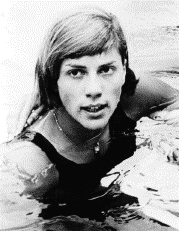
Kiki Caron
On the 16th of February Ann Fairlie and Kiki Caron clashed in the Hillcrest Pool in Pretoria, where Fairlie won a time of 1:09,1, beating the French swimmer by 5 yards. Coach Frank Gray had refused permission for Karen Muir to travel to Pretoria for the race. In fairness to Caron - she had arrived from France only a few days before, out of the northern hemisphere winter season, and was swimming on the highveld, at 5000 feet above sea level.
A rematch between Fairlie and Caron had been planned for two days later, at Ellis Park in Johannesburg, with Karen Muir joining in. The press reports describe a fantastic race, watched by huge crowd of 5000 spectators. Little Karen was the world record holder, but Ann Fairlie was a Johannesburg local, obviously the crowd favourite, whose fastest time was barely 0,2 seconds slower than Karen's record.
Karen - now 13 - who would have been driven up from Kimberley to compete in the special gala. Despite being the world record holder over 100 yards, Karen had never actually beaten Ann Fairlie in a backstroke race, having finished behind her at nationals and of course she swam in the junior race in Blackpool, where Fairlie won both senior backstroke events.
At Ellis Park, Ann Fairlie won the race in 1:08,9 - with Karen second by one-tenth, and Kiki Caron a distant third in 1:13,0. Ann's time was just 0,2 seconds slower than Karen's world record - it's easy to see why there was so much excitement! Karen's race was marred by a poor start and a tangle with the lane rope. Losing the race to Ann Fairlie must have been quite a blow to Karen Muir - and her very competitive coach Frank Gray.
The swimming moved to the new Queens Park pool in Karen's hometown of Kimberley for a rematch. The local swimming enthusiasts were used to seeing international swimming as SAASU had previously hosted international events there. The organizers were hard-pressed to accommodate all of the spectators, as tickets were sold for R1, and bookings for the gala could be made at a local jewellery store! Swimming was big entertainment in Kimberley, with their very own world record holder Karen Muir.
Unfortunately, the officials had their own plans - they had scheduled a 220-yard backstroke for the gala. Once the swimmers arrived in Kimberley, Cecil Colwin, who was Ann's coach, refused to let her swim the 220-yard race, arguing that they had come prepared for the 110-yard distance. Eventually, the local officials gave in, and the 110-yard distance was swum.
Ann Fairlie’sfirst world record - Kimberley, 21 February 1966
South Africa was soon to have two teenage world record-breaking backstrokers. In Karen’s home pool in Kimberley - the South African champion Ann Fairlie set her first world mark when she broke Karen Muir's world record! Karen had a poor start and was catching Fairlie at the end of the race, resulting in a very close finish. In this pre-electronic era of the 1960s, spectators had to wait for ten minutes while the officials worked out exactly what had happened. The final results were - Fairlie 1:08,6 (WR), Muir 1:08,8, with the French swimmer Kiki Caron third in 1:12,1.
Karen, and her coach Frank Gray, must have been devastated! Karen and her parents were absent from the official mayoral reception held the next day, where new world record holder Ann Fairlie and the charming Kiki Caron were feted. No doubt Karen was at home - planning her revenge.
The next event was scheduled to be held at the Beach Baths saltwater pool in Durban. An improved performance was expected from Kiki Caron, while Cathy Ferguson had arrived from California during the week. The South African national championships were due to start the following week, and a special gala had been organized for the backstrokers, to be held on the Saturday before. Ferguson had other ideas - after travelling for three days, she declined to race the South Africans, agreeing only to do an exhibition swim.

World record number 2 - Durban, 26 February 1966
At a special gala in Durban in the 100-yard-long salt water-filled Beach Baths, reduced to a 55-yard course for the event, 13-year-old Karen Muir broke a world record for the second time. Kiki Caron and Ann Fairlie were in the race, although Olympic champion Cathy Ferguson had not yet arrived in the country.
Karen swam the 110-yard backstroke in 1:08,3 - taking 0,3 seconds off the world record set by Ann Fairlie just six days before. She took advantage of an improved starting technique, and started her turn one yard ahead of the field, and maintained that lead to the finish. Fairlie was second in 1:09,0 and Caron in an improved 1:10,2.
Her coach Frank Gray had identified the poor starts as a problem, and they worked to fix that during the intervening 6 days, despite her misgivings about beating Ann Fairlie - which would have been a first for her - she overcame the disappointment of Kimberley and triumphed in Durban.
The 1966 South African swimming championships were due to start there two days later, with the women's 110-yard backstroke final scheduled for Tuesday evening. In all the excitement of the world records, and races won in faraway places, Karen would still have been very aware that this was the big stage of South African swimming - where she had yet to win a gold medal! Karen had spent countless hours in the pool, training with the other swimmers, dreaming of swimming glory.
For most swimmers world records would probably not have been their dream; qualifying for nationals, making a final, winning a medal - and ultimately a national title, was the pinnacle of sporting achievement for South African swimmers, who were banned from competing in the Olympic Games. For very select few there was the added and elusive reward of Springbok colours - a rare achievement in those days - only for representing South Africa in an international event. As one Olympian said, "World records are there to be broken but medals are there forever and you can hold onto them."
For Karen Muir, an Olympic gold medal was never something she could achieve - she already held the world record anyway. For her, a first title at the South African championships, in front of her peers, would have been very special.
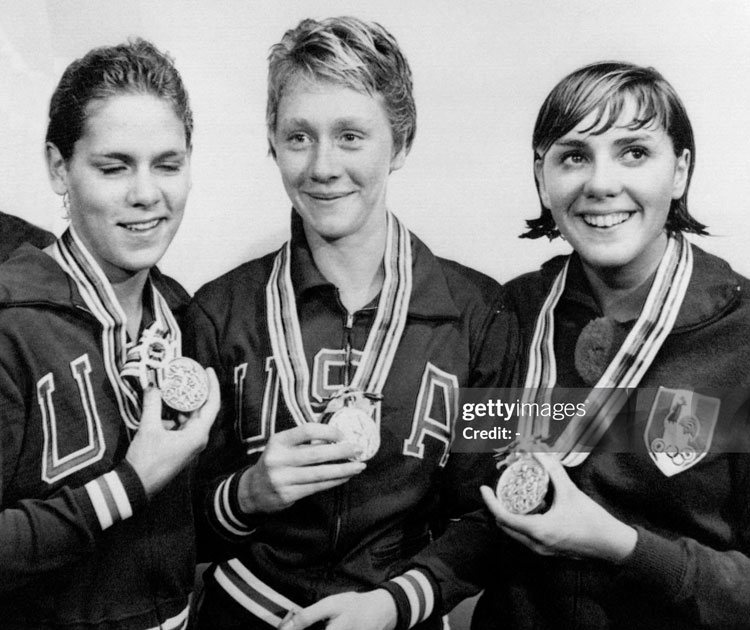
1964 Olympic medallists - Virginia Duenkel, Cathy Ferguson and Kiki Caron.
Relive the moment America's Cathy Ferguson set a world record by winning the 100m backstroke at the Tokyo 1964 Olympic Games. This is who Karen was up against in Durban, and to make it extra special - the current Olympic gold and silver medalists were there to be beaten. Cathy Ferguson and Kiki Caron represented the world Karen was excluded from, but here they were, in her backyard, to be measured, and Karen did not disappoint.
The local press billed it as the Olympic final that never was - Ferguson, Caron, Fairlie and Muir - the four best female backstrokers in the world, having it out. Not only were the stands packed with Durbanites coming to see an extraordinary sporting event, but the cream of South African provincial swimming was also there for the premier event on the annual SA swimming calendar. For any sportsman, the abiding memories of their career are the relationships with teammates and archrivals. They had seen Karen swim at two previous nationals, where Ann won both times and now they were in Durban for their national championships.
Added to the usual tensions and excitement was the possibility of world records, and Olympians Ferguson and Caron, who were no strangers to the big stage. Karen had never swum against the Olympic champion Cathy Ferguson, and she was the one Karen was most afraid of.


World record number 3 - Durban, 1 March 1966
The 1966 South African swimming championships were held at the Beach Baths in Durban. The 13-year-old Karen Muir broke the 110-yard backstroke world record in that same pool for the second time in a week - by a further 0,3 seconds - finishing in 1:08,0. Ann Fairlie was second in 1:08,7, Kiki Caron took the bronze in 1:09,5 and Cathy Ferguson ended fourth in 1:11,1. For the South Africans justice had been done - their champions were the true world champions!!
In the 220 yards backstroke South African championship Karen also took gold, beating Kiki Caron into second place, with Ann Fairlie in third and Cathy Ferguson again in 4th place. Although missing the world record by a mere 0,4 seconds (another world record had probably been expected!), her time was 1,3 seconds better than Ann Fairlie's South African record.
Back at school in Kimberley, Karen swam in her school gala - winning all of the backstroke, freestyle and butterfly events, in the girls under 14 age group. Alas, not even a world champion could help her house team - which finished last! She had a busy month outside the pool - presenting prizes at other school galas in Kimberley, and unveiling a bronze plaque to commemorate her first world record. The mayor had promised her the plaque when she returned from Blackpool in August of the previous year - but now he said that had been some “practical difficulties” in erecting the plaque, and besides - We can’t put up a plaque every time you break a world record!
Meanwhile, Karen and her coach Frank Gray were plotting her next move. He set up a trip to Italy for the end of March 1966, where Karen would compete in an international event in Milan. The trip was due to an invitation from the Italian Swimming Federation, via the South African Swimming Union, who did not approve of Frank accompanying his swimmer as a coach - they always sent their own man Alex Bulley as coach. Frank made it clear that he was going anyway - with or without their approval. Funded by generous contributions from local sponsors, Frank Gray and Karen, accompanied by her mother Yvonne, set off for Milan. Coming from an Afrikaans town like Kimberley - it was to be an experience for her!
At the 33,3 metres Piscina Cozzi of Milan Karen competed against swimmers like Romanian swimmer Cristina Balaban who won a bronze medal in the 100 m backstroke at the 1966 European Aquatics Championships and Russian Natalya Mikhaylova, who would finish second behind Karen in the 100m backstroke event. Frank Gray wrote from Milan - explaining how his champion was coping with the attention. In the end, it was all probably a bit much, as Karen ended up in bed with a severe cold! But like any teenager, she was soon back on her feet to be a tourist in Naples and Rome, giving exhibitions to schoolchildren. Before leaving for home she attempted the 200m-backstroke world record of 2:27,7, held by Cathy Ferguson. Having just seen off the American challenge in Durban, she must have fancied her chances of setting a new record. Swimming in the mosaic magnificence of the Foro Italico she had a bad start, and failed to break the world record, despite a split of 34,4 over the last 50. However - she was to break that record twice in the next few months, and again in 1968.
Returning to Kimberley again was not to be without some difficulties. In what must have involved some high-level diplomatic scrambling, the Muirs and Frank Gray were allowed to travel home - without any passports. Frank Gray wrote a report of their trip for the people back in Kimberley, who were following Karen's travels in the Diamond Field Advertiser.
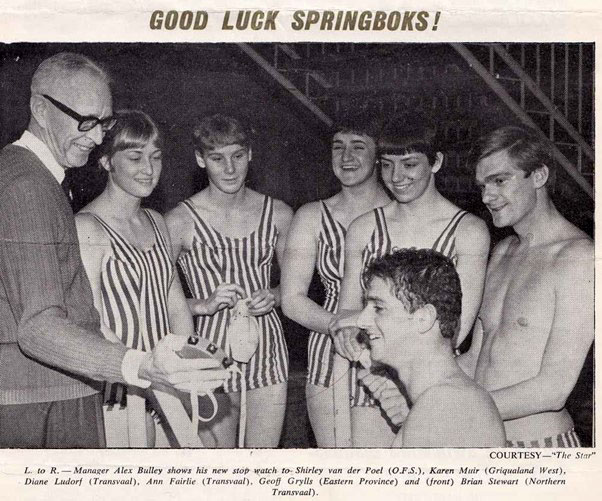
In July 1966 Karen undertook another extended Springbok tour - to France, the USA and Canada. The British ASA, probably tired of the South Africans winning all the titles at their nationals, had changed their rules to allow only British-born swimmers to swim in the ASA nationals. Instead, SAASU had arranged a tour of France and the USA for July - and also to Canada to compete at the British Columbia centenary celebration gala.
In France, they were to swim unofficially in an international gala involving Spain and Italy, while in the USA they would take part in the Los Angeles Invitational and the US Swimming nationals in Nebraska. The Canadian invitation would extend that trip right up until the end of August. Luckily for Karen's academic aspirations, the trip coincided (mostly) with the SA winter school holidays - certainly a factor in deciding whether to allow her so much time away from school.
At the time visiting Australian great Ilsa Konrads had written a series of swimming articles for a local newspaper, in which she criticized the arrangements made by SAASU for the trip. In particular - their continued insistence on Alex Bulley being the only coach on tour, and their refusal of permission to accompany her coach Frank Gray to London, where she would have been able to prepare for the tour in a heated pool. Friction with SAASU and the management of Karen Muir was to have a big impact on the 1967 tour.
Swimming training in cold water, which is all Kimberley could provide, was not a viable option. As a result, Karen was forced to travel to Johannesburg, to train in the unfamiliar surroundings of the Summit Club in Hillbrow.
On tour, Karen accompanied by the older Ann Fairlie - once again received extensive press attention, while the swimming officials scheduled sightseeing trips, which exhausted the swimmers. Their first gala was in the French town of Beziers, where they were allowed to swim unofficially in an international event including Spain, Italy and France. Although not part of the official international competition, the South African swimmers certainly made an impact as first Ann Fairlie and then Karen Muir world backstroke records.
Ann Fairlie's second world record - Beziers - 23 July 1966
Fellow Springbok swimmer and arch-rival Ann Fairlie set her second world record when she broke Kathy Ferguson's Olympic winning time in the 100m record, in a time of 1:07,4. Karen was second with Kiki Caron in third place. Caron was to win the European Championships in 1:08,1 later that summer, beating Linda Ludgrove and Christina Balaban.
The photo below shows the three - with Karen Muir looking less than happy with at the occasion! Two days later she sets her own new world record in the 200 backstroke.
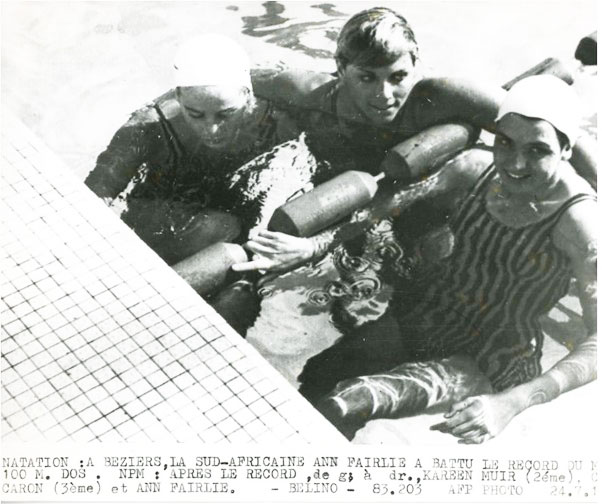
World record number 4 - Beziers, France, 25 July 1966
Karen Muir's response to Ann Fairlie's world record-breaking effort was to set a new world record for the 200m backstroke, held by Cathy Ferguson since September 1964. Ann Fairlie finished second, with the French champion Kiki Caron finishing third. This was the record Karen had attempted to break during her trip to Rome earlier that year.
Watched by her parents Karen had a good start, but France's star Kiki Caron touched first at the 50-metre turn. Then Karen caught up and raced into the lead, boiling the water around her. When she started the last lap the large crowd rose to shout and urge her on. She beat Ann Fairlie by eight yards.
"I had no idea I was near the world record," Karen Muir said afterwards.
After France they crossed the Atlantic, and the USA, to California, to swim in the famous Los Angeles Invitational gala. This was a big event in US swimming, featuring all of the best American swimmers and drawing a huge crowd to the Los Angeles Swimming Stadium. Karen would remember the noise from the indoor pool at Blackpool, and the large crowd in Durban during the South African nationals, but this would have been another huge step up for her. She was the current world record holder - from faraway Kimberley, on the fringes of civilization - coming to the centre of world swimming. In 1976 more medals would be won at the Olympics by swimmers from southern California – than by the rest of the world combined. This was indeed the big time for Karen!
A familiar face in the crowd for Karen was Patty Caretto - seen below during her in Kimberley earlier in the year. Another was Cathy Ferguson, who had swum against Karen in Durban earlier in the year and was a Los Angeles local. Ferguson was the first-ever international Swimmer of the Year in 1965 - an accolade won by Penny Heyns in 1996 and 1999. Making the cover of Swimming World magazine was an achievement and an honour for both swimmers.
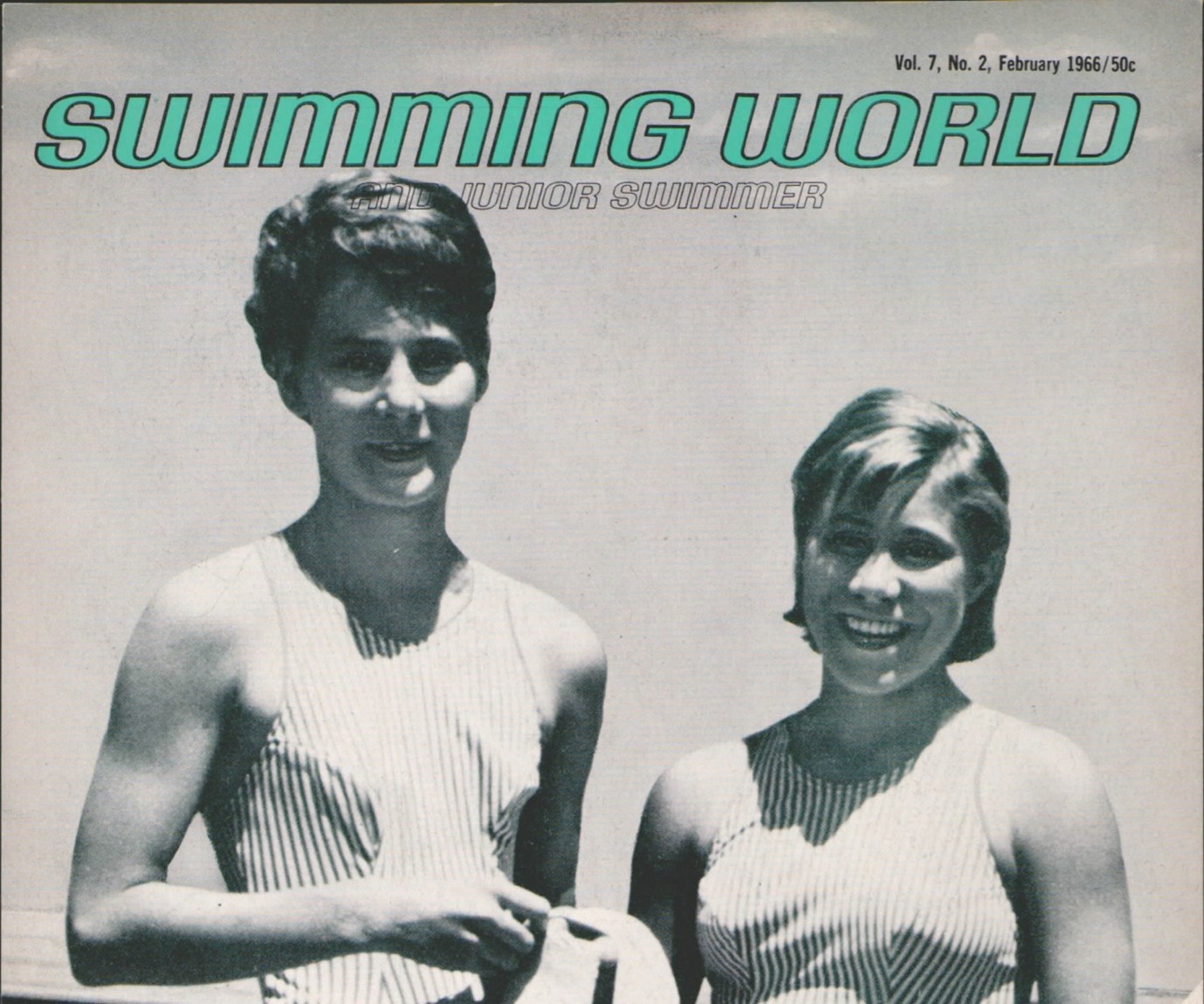
Click here to see a video of Patty Caretto, which gives an insight into life on the road for young international swimming girls like her and Karen Muir. The chaperone on Patty's trip to South Africa was coach Jane Stafford, who had met Jennie Maakal at the 1932 Olympic Games.
On 2nd August 1966 at the Los Angeles Invitational meet, Karen Muir won the 200m backstroke in a meet record time of 2:28,1. Her time was a second slower than the world record she set in Beziers. She also second to Claudia Kolb in the 200m medley. Kolb was to set a new world record later that month at the US nationals in Lincoln, while Karen and Elaine Tanner would set a combined new mark for 220 yards IM at the Canadian gala in Vancouver.
In August 1966 AAU nationals were held at the Woods Pool in Lincoln, Nebraska.

It was the next destination of the Springbok tour. They were joined there by several South African swimmers, like Vernon Slovin (a former Frank Gray squad member) and Basil Hotz from Johannesburg, who were swimming for American universities. The pool was a 50m outdoor venue, which turned out to be a problem, as the weather turned cold and hampered the swimmer's performance. Lincoln is perhaps more well known in recent South African swimming circles as the home of the University of Nebraska swim team - where world record holders Penny Heyns, Peter Williams and other South Africans would receive university scholarships. At the end of the tournament, the Springboks won two titles and a silver, with Ann Fairlie winning the 100 backstroke and Karen Muir the 200 backstroke in a new world record time.
The cream of US swimming was there - Mark Spitz, Don Schollander, Catie Ball, and Charlie Hickox were to compete - and Patty Caretto who was to set a WR for the 1500m freestyle. Don Schollander would also swim at the gala in Vancouver later in August, and then he visited South Africa in the following year.
While the Olympic Games limit entries to two swimmers per country in each event, the full depth of American swimming is present at their nationals. Little wonder the South African men largely failed to impress, despite setting several new South African records, but in women's backstroke the Springboks were supreme.
World record number 5 - Lincoln, Nebraska, 19 August 1966
Karen swam 2:26,4 to win the 200m backstroke at the American AAU national championships at the Woods Hole Pool in Lincoln by 2,5 seconds. With a split at the 100 of 1:09,4, she took another 0,7 out of the record she set in Beziers!
Karen's new record time from Beziers had not yet been ratified by FINA, so Cathy Ferguson was still on record as the official world record holder at 2:27,4. Ferguson finished this race in 4th place.
In the 100m backstroke, South Africa took the first two places - with Ann Fairlie winning in a new AAU record of 1:07,9. Karen Muir finished in second place in 1:08,4 and Cathy Ferguson in third place in 1:10,1.

After the AAU nationals, the team travelled north to the Canadian city of Vancouver, where the state of British Columbia was celebrating a centenary of the Canadian Federation. A swimming gala was held at the University of Columbia outdoor pool, with swimmers from the British Commonwealth competing.
Here Karen also met Canadian star Elaine Tanner, with whom she would have many future encounters. Tanner had previous experience of Karen Muir in action - she had been in Blackpool the previous summer - when the 12 year-old set a new world record in her own event - which was something she probably never forgot. Tanner was to travel to South Africa in the next year - to brace Karen Muir in her own backyard.
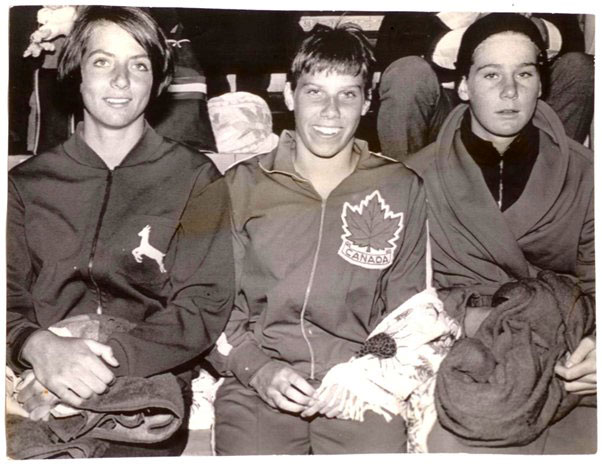
World record number 6 - Vancouver, Canada, 26 August 1966
In Vancouver Karen, despite suffering from a back strain, set a new world record for the 220 yards backstroke in during her heat.
She beat Canadian champion Elaine Tanner by two seconds.
Alex Bulley described her swim: She still hasn't learned to turn. She keeps trying to look ahead instead of using the overhead marker flags and then says 'Oh, I forgot'
On the next day, Friday 27th August 1966, Ann Fairlie beat Karen into second place in the 110-yard backstroke and set her third world record. Ann Fairlie recaptured the 110-yard world record from Karen in a time of 1:07,9.
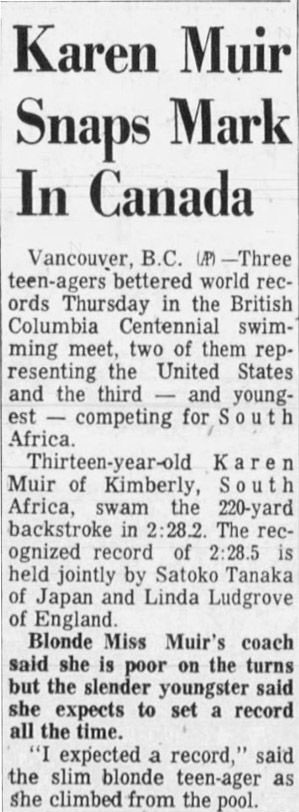
Karen's 7th world record was for the 220-yard individual medley. Karen and Elaine Tanner finished tie in the race - well, sort of. Karen's timekeepers recorded her with the fastest time at 2:32,0 and Tanner with a time of 2:32,1. However, the (Canadian) touch judges claimed that Elaine had touched first.
FINA had previously decreed that world record could be shared, but the lawyer Harry Getz - President of SAASU, argued against Karen Muir being awarded the world record. He claimed the Canadians had not heard about the time Claudia Kolb had done at the US championships, where Karen and the rest of the team had just competed. Kolb had done a time of 2:7,8 in the 50m metric pool at Lincoln.
World record number 7 - Vancouver, Canada, 28 August 1966
Despite Karen finishing with the fastest time 2:32,0 and Tanner's 2:32,1 the Canadian judges ruled Tanner to be the winner, and they were both supposed to hold the world record. Tanner set the previous mark of 2:33,3 in Vancouver on 2 July 1968, during a time trial held at the British Columbia Open and Age Group Championships. She broke the previous record by three-tenths of a second, held by Donna de Verona of Santa Clara in California. Claudia Kolb won the US title in August 1966 in 2:27,88, although that would only recognised as a new record by FINA on 31st December 1966.
Tanner is seldom credited with this world 220-yard individual medley world record, and unfortunately, no records of Word Records in yards-times seem to be publically available any more, so it remains difficult to confirm today. However, contemporaneous newspaper reports do credit both Muir and Tanner with the achievement and if anyone knew about the 220 yards IM world record progression at that time - it would be the Canadian press, which wrote:
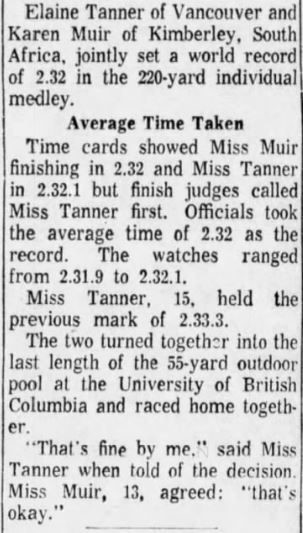
In South Africa, the South African Amateur Swimming Union, headed by Cape Town lawyer Harry Getz, refused to credit her with the record (they also did not recognise the world records set by Jonty Skinner and Peter Williams). In 1968 SAASU also refused to recognise Karen Muir's world record for the 200m backstroke set in Los Angeles, until Karen van Helden beat the then-official SA record time of 2:24,1 in a time of 2:23,8 - equal to Muir's unrecognised time. Only then did SAASU agree to accept Karen Muir's 2:23,8 world record, which Karen van Helden eventually did break on 8th March 1978, in 2:21,4.
After the gala in Vancouver, the Springboks made their way back to South Africa. It is hard to imagine the effects of an extended overseas tour on a 13-year-old girl from a dorp like Kimberley – particularly one known to be shy and without her mother nearby for support. Karen was to receive a hero's welcome in Johannesburg, where the SAASU management turned out, with the local mayor - and another when she eventually arrived in her hometown of Kimberley.
By September 1966 Karen was back at school. At Diamantveld Hoërskool she was awarded her full colours for swimming - the school's highest accolade for a sportsman. This honour is usually reserved for older pupils - but in Karen's case they are an exception! Life returned normal - Karen and her sister Linda were selected to swim for their province against Northern Transvaal, while coach Frank Gray had to deal with the perpetual problem of South African swim coaches - pool time.
Ann Fairlie returned from the extended overseas tour to focus on what was a priority - catching up on her schoolwork for matric. The tours were to hurt Ann's schooling, as she failed matric that year and declined to tour the next year, as she had to repeat. No doubt this too had an impact on Karen and her parent's view of her jet-setting. While Karen and Ann may have been competing in faraway places like France and Canada and overseas travel was still unknown to most South Africans, life at home and school and the swimming squad remained the main focus of everyday life.
1967 - big change and another momentous year for Karen Muir.
At the end of 1966 Karen's father accepted a post at Onderstepoort Veterinary School near Pretoria, so the whole family was to move to the northern Transvaal. It was headline news in Kimberley - their darling was leaving! In Pretoria, Karen was to train under Australian coach Bob Campbell. That meant leaving her first coach Frank Gray, and the life she had just begun at Diamantveld High School in Kimberley. The move must have been an unhappy one, as she was to return to Kimberley and Frank Gray by the end of the year.
In 1967 the big swimming news for the coming year was the visit by a Canadian team, which included Elaine Tanner. During the winter the Springboks toured Holland, Spain and England, and in December 1967 US star Don Schollander toured around the country. Ann Fairlie missed the European tour that year, having to make up for failed matric the year before, which underlined the impact of these tours on Karen’s academic life.
World record number 8 - Hillcrest, Pretoria, 28 January 1967
At the Northern Transvaal championships at the Hillcrest pool, Karen improved her 220-yard backstroke world record set in Vancouver by ,05 seconds in 2:27,7 - finishing 15 seconds ahead of second-placed Diane Ludorf. Karen had been training with coach Bob Campbell
By then she had won almost all of the titles at the championships – only narrowly missing out on the 220-yard breaststroke!

In February 1967, while swimming in Northern Transvaal colours at nationals at Ellis Park in Johannesburg, Karen was challenged by visiting Canadian champion Elaine Tanner, who won 5 SA titles, while Karen took three. Her local rival Ann Fairlie had broken with her coach Cecil Colwin – and decamped to Kimberley to be coached by Frank Gray!
In July 1967 the Springboks once again embarked on an extended tour of Europe, competing at Tarasa in Spain, and the 'Seven Hills' Tournament in Rome, ending the tour with a gala against the British team at Coventry. The tour was to be a stormy one not only for Karen, who delayed her departure to spend more time on her schoolwork. She joined the team in Holland on the 30th of June 1966. Karen was accompanied by a “personal chaperone” – a journalist from Die Beeld newspaper, who also shared Karen’s hotel room. This caused some problems within the team, and in the end, Karen's father flew to London after reading reports about some unhappiness caused by the SAASU official's treatment of their star swimmer. He threatened to take her home immediately. However, the matter was resolved, and Karen swam against British champion Linda Ludgrove at the event in Coventry.
World record number 9 - Coventry, England, 22 July 1967.
Briton Linda Ludgrove was five years older than Karen and had been the 110-yard backstroke world record holder two years earlier when she beat Ann Fairlie at the 1965 ASA nationals. At the same event where Karen broke that world record, swimming in the junior event. Ludgrove was to retire three weeks later, after winning the 110-yard backstroke at the ASA nationals in Blackpool earlier in the year.
The British press suggested Ludgrove had not swum any competitions yet that year, she had represented Great Britain at an event in Italy in March 1967, where she had finished fifth in the 100m backstroke. Ann Fairlie had stayed at home to study for matric, and Linda Ludgrove had to contend with Karen on her own. Despite keeping up with Karen until the turn, she was no match for Karen, who finished 1,2 seconds ahead of her, in a new world record time of 1:07,5.
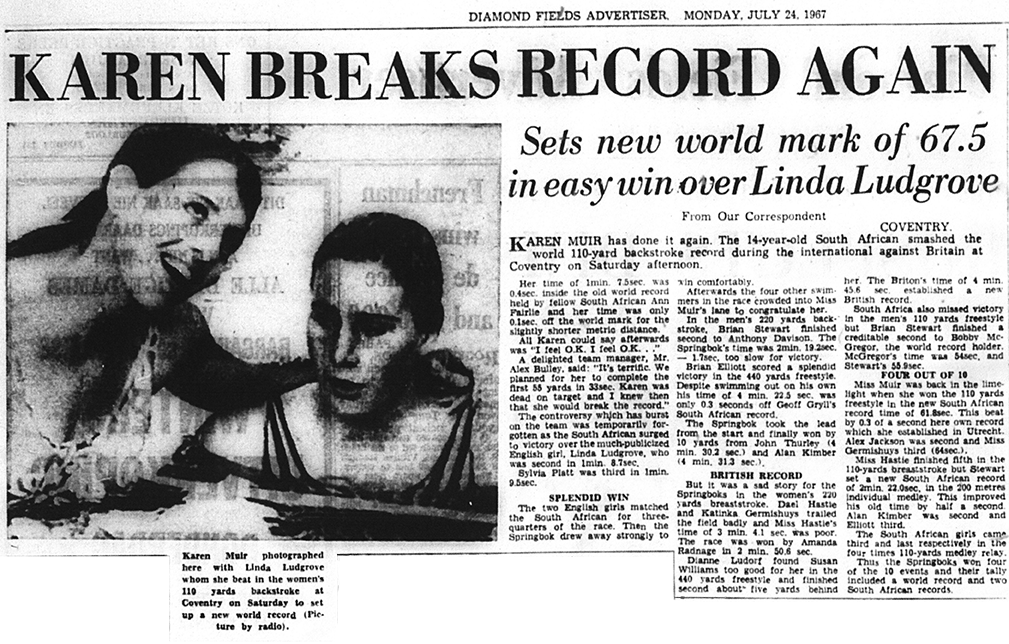
By the end of 1967, Karen was back in Kimberley, competing for Griquas and training with Frank Gray and at Hoërskool Diamantveld, where she matriculated in 1970. Ann Fairlie had decided to quit swimming.
1968 started with more world records
Now aged 15 Karen was in standard 8, and the big news was the possibility of South Africa being allowed to compete in the 1968 Olympic Games, after being barred from the 1964 Tokyo Olympics.
The Canadian girls were again expected to swim at the SA nationals in Bloemfontein and US Olympic hero Don Schollander was touring South Africa.
After his visit, Schollander later wrote about an encounter with Karen, during which she gave him a note, asking for his help in getting South Africa back into the Olympics. Her plea was that all her life – all she had lived and trained for – was the chance to prove herself in the Olympics. After the IOC officially voted to include South Africa in February, SAASU even went so far as to pick a team to compete – only to be told at the last moment that they would not be allowed to compete.
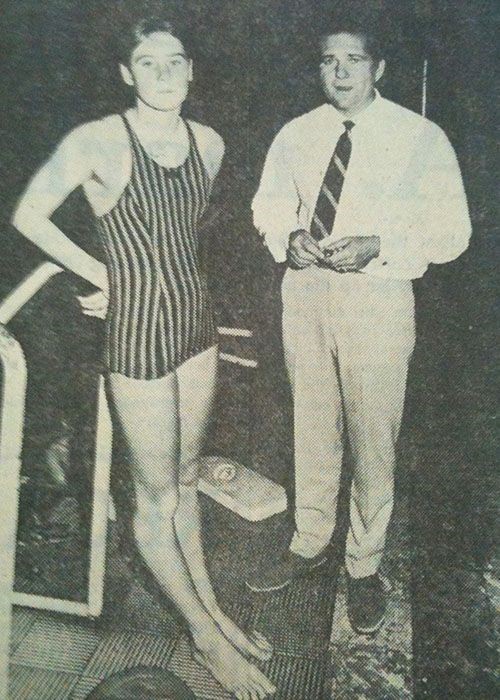
Karen Muir and coach Frank Gray
World record numbers 10 and 11 - Kimberley, 26 January 1968
At the Griqualand West swimming championships held in the 55-yard Kimberly municipal pool, Karen Muir set 4 world records in two races.
On the 26th of January 1968, Karen set a new record time for the 200m and 220 yards backstrokes at her home pool in Kimberley, in 2:24,1. This was three seconds faster than the world record set in Pretoria 12 months earlier at the Northern Transvaal championships.
Because a 55-yard pool is longer than a 50-metre pool, FINA regulations recognised both yards and meter records if the swim was done in the longer pool.
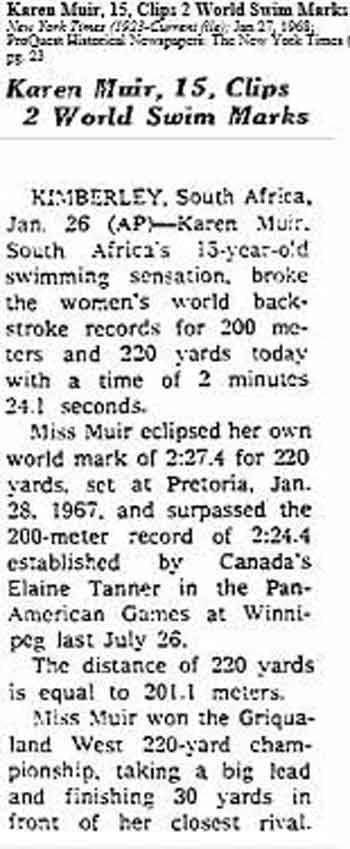
World record number 12 and 13 - Kimberley, 27 January 1968
The next day she set new marks for the 100m and 110 yards events, in a time of 1:06,7.
She broke the world record set by Elaine Tanner, in July 1967, as well as her own 110 yards world record record of 1:07,5. The London Times of 29th January 1968 carried the report.

The 1968 South African swimming championships were held in Bloemfontein that year and featured the team from Canada. Unfortunately, Karen suffered a swimmer's shoulder injury and failed to compete in most of her usual championship events. Elaine Tanner of Canada won both the backstroke events.
Karen did win the 220-yard freestyle at nationals and was selected to swim for South Africa against the Canadians in a Test, where she beat Elaine Tanner in the 100m backstroke.
After nationals and the Test against Canada, Karen swam at the South African Schools Championships, before leaving for another extended tour overseas.

World record number 14 - Paris, 6th April, 1968
Karen again set a new world record of 1:06,4 for the 100-meter backstroke in Paris, beating her record of 1:06,7 set in Kimberley. This time was beaten at the Olympic Games in Mexico City by Kaye Hall who won the gold medal in 1:06,2. Karen was to break this record once more - at Utrecht in 1969.
After getting very sick with double pneumonia in France, they went to Canada, but the trip was cut short because of civil unrest in the USA, resulting in a USA/Canada border closure. The pneumonia probably also had an effect on her swimming!
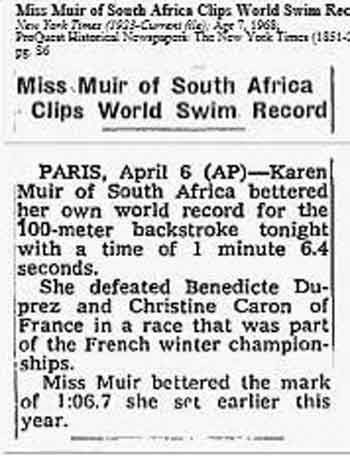
After returning home for two months, Karen embarks on another trip to the USA. In early June 1968, she moves to Johannesburg with her mother, to train at the indoor pool of the Sumitt Club in Hillbrow. Kimberley lacked any heated swimming facilities, and despite the sunny weather, temperatures often dipped below freezing during the winter months.
There was talk of her swimming at the ASA nationals at Blackpool in August, but nothing ever came of the suggestion, because "her entry was too late". She was also scheduled to swim in the Canadian nationals, until they decided to make their event "a closed affair".
The US swimming control body reacted to Karen's banning from the Olympics by staging a "mini Olympics" at Santa Clara. At this event on the 8th of June 1968, Karen broke the US record for the 100m backstroke, beating Elaine Tanner and American Kaye Hall. Hall was to win the 100m backstroke at the Mexico City Olympic Games on the 23rd of October 1968. Hall set a new world record, beating Karen's world record time by 0,2 of a second, while Karen was back in Kimberley studying for her end-of-year exams!
After the Santa Clara meet, Karen travelled up to Los Angeles, to swim in the annual Los Angeles Invitational.
World record number 15 - Los Angeles, 12 July 1968
Swimming at the Los Angeles Invitational again, Karen Muir set a new world record in the 200m backstroke, finishing in 2:23,8, which beat her time record of 2:24,1 set earlier that year at Kimberley.
Susie Atwood of the USA was to break the record with a time of 2:21,5 one year later, while Lillian Watson of the USA won an Olympic gold medal in this event in August 1968 in the slower time of 2:24,8 – which was also a new Olympic record.
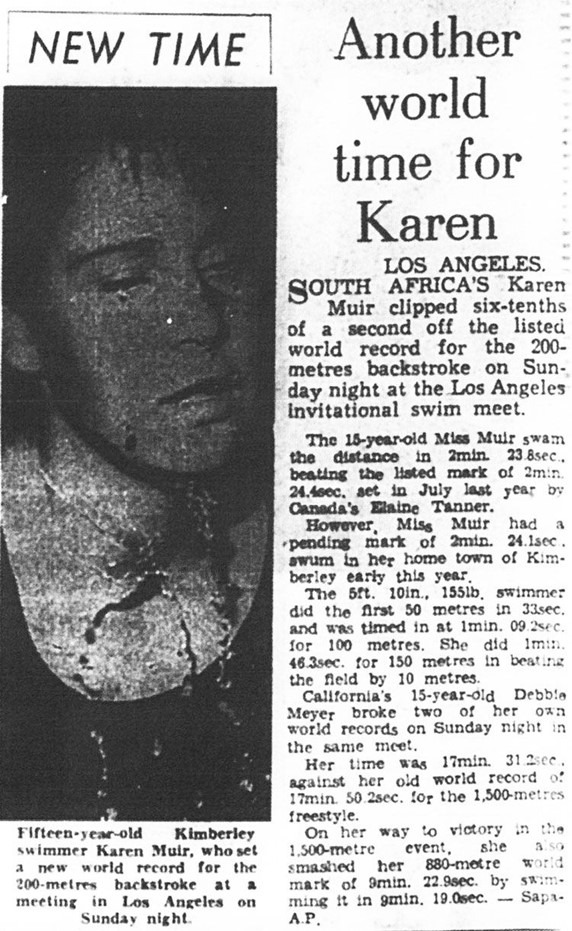
At the American AAU Championships held in Lincoln, Nebraska, Karen won the 200m backstroke in a meet record but failed to beat her time set in Los Angeles. In the 100m backstroke, she beats Ann Fairlie's meet record from 1966 and sets a new US record of 1:06,9.

Karen returns home, to school, while the rest of the swimming world competes in the 1968 Mexico Olympic Games, where Kaye Hall breaks Karen's 100m world record, while Pokey Watson of the USA wins the 200m backstroke in 2:24, 8 - a full second slower than Karen's world record set in Los Angeles.
In January 1969 a strong contingent of American girls visited South Africa – Jan Henne, Sue Perdeson and Linda Gustavson, who had won gold silver and bronze at the 1968 Olympic Games, where Pam Kruse won silver in the 800m freestyle.
At a gala in Cape Town on 8th January 1969 Karen Muir beat Linda Gustavson into second place in the 220-yard freestyle. Gustavson had won silver in the 400 freestyle and bronze in the 100m freestyle at the Mexico Olympic Games.
World record number 16 (or not) - Kimberley, 22nd January 1969.
On the 21st January 1969, at the Griqualand West swimming championships in the 55-yard Queens Park pool in Kimberley, Karen swam 5:21,3 for a 440 yards IM, which beat the previous world mark of 5:25,1 set by American Mary Ellen Olcese, on the 21st of August 1965 at a USA/GB dual meet in Cardiff. Many reports state that Olcese held her record until the event was retired on the 1st of May 1969, despite Karen setting a better time in January 1969. Some sources claim that the cut-off date for yards-times was 1st May 1969.
At the FINA congress held during the 1968 Olympic Games, it had been decided to only recognise swimming world records set in 50-meter swimming pools. Most of the "Olympic" pools in South Africa, like the Kimberley and Newlands swimming pools, were 55 yards long., before being shortened to a 50 meter length.
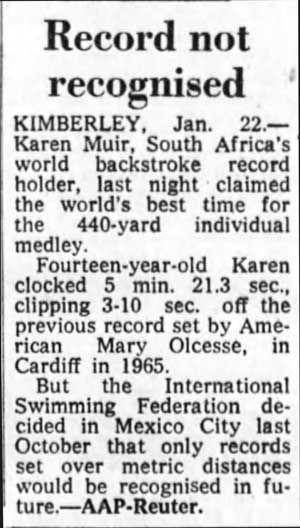
The 1969 South African national swimming championships were held at the 55 yard Newlands pool in Cape Town. For Karen Muir, it was probably a small affair, compared to the galas she had swum in over the past year, but for South African swimming it was a fantastic occasion, which produced some remarkable races. Karen Muir would set a world record, and a South African record for winning six individual titles.
World record number 17 (or not) - Cape Town, 1st March 1969.
On the last day of the South African championships at Newlands in Cape Town, Karen sets a new time in the 440 IM. Her time of 5:20,2 improved the record set at Kimberley in January. Unfortunately, both records were never officially recognised by FINA.

On the 14th of March 1969, Karen swam at the SA Schools gala, also held at Bloemfontein’s Stadium Pool, where she won both the events she competed in.
The 1969 South African Games started in Bloemfontein during the following week, where Karen was selected to open the event. She set a new SA record for the 200 IM but made no effort to break the backstroke world mark. Besides the effects of swimming at altitude, the Stadium pool in Bloemfontein was heated, but rather too shallow in one end, and not compliant with the FINA standard of 1,8m for a competition pool.
On the 12th of April 1969, the Beach Baths in Durban was the venue for the Top Ten Age Group gala - the top ten swimmers in each event and each age group were invited to swim. Karen went down the Durban 19 days early, to swim with Alex Bulley and prepare for an attempt on the 100m-backstroke world record. On the day she could only manage a time of 1:08,3, which was 2,1 seconds slower than the meters record held by American Kaye Hall.
Before her final European tour, Karen started training with Alex Bulley in Durban, in May 1969, as Frank Gray was moving to coach in Sasolburg. This must have been a challenging situation for Karen, who was in the penultimate year of high school, with her sights set on getting into medical school at the University of Orange Free State in Bloemfontein after finishing matric in 1970.
World record number 18 - Utrecht, Netherlands, 6th July 1969.
Swimming the first leg of a medley relay, Karen sets a new world record for the 100m backstroke with a time of 1:05,6. This world record stood for 4 years until beaten by East German Ulrike Richter at the World Championships, held at the same pool in Utrecht. The German, and the rest of her team, were later denounced as drug cheats.
FINA world records can be set in the first leg of a relay race. In 1976 Jonty Skinner was accredited with two world records in one swim - the 50m of 23,86 which was his split for the 100m world record of 49,44.
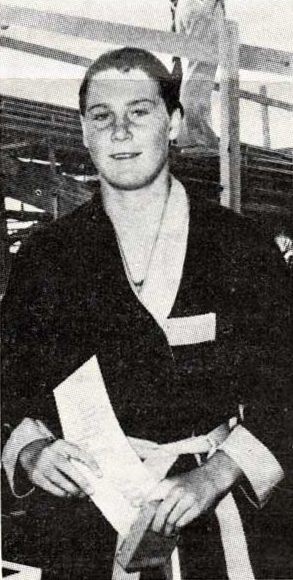


1970 - Matric
With her final year at Diamandveld Hoërskool and matric exams looming, Karen was scaling back her swimming to ensure she did well enough in the exams to qualify for a place at medical school.
In March 1970, at the Hillcrest pool in Pretoria, Karen swam for Griquas in the SA championships, where she won the 100-meter backstroke in 1:07,4. She also won the 100 butterfly in a new SA record and won the 200 and 400 IM, without getting anywhere near world record times. She was now in the final year of high school and focused on her studies, to realize her lifelong ambition of becoming a doctor.
Earlier in the year Springbok swimmers competed against Rhodesia – without Karen, while in March 1970 she did compete against the touring Australians Allyson Mabb, Lynn Watson, and Karen Moras.

1972 - Karen Muir with Springbok and Rhodesian swimmers

